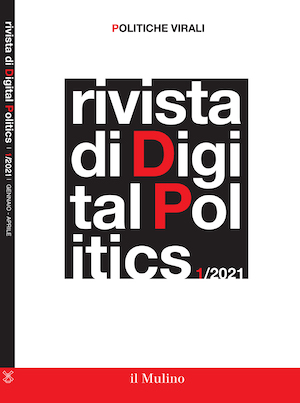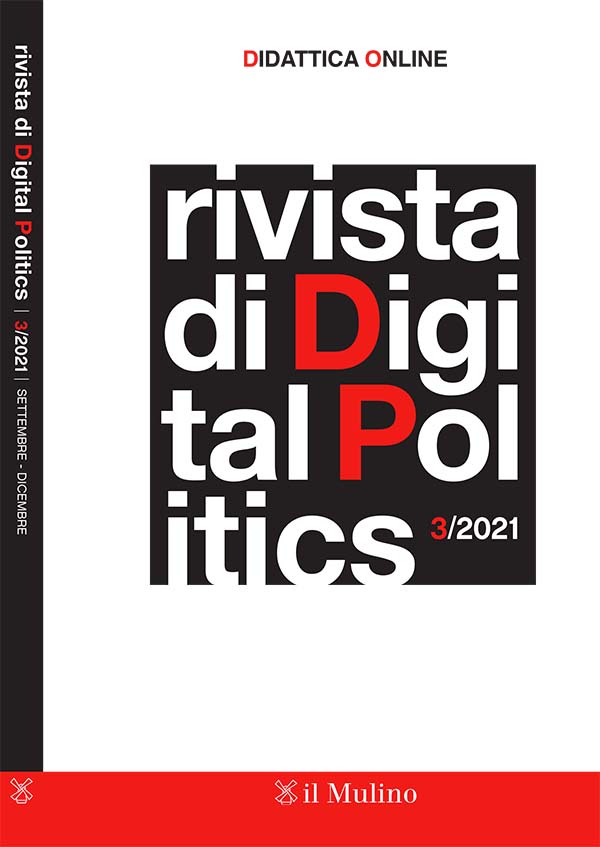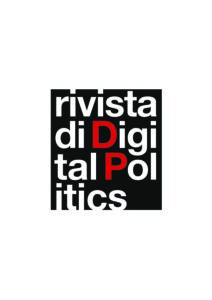- Mauro Calise, Virus contro Virus
- Leonardo Morlino, Ripensare la rappresentanza: la manipolazione digitale
- Daniela Piana, Augmented democracy. More open, less free?
- Gilberto Capano, Rincorrere, rincorrere, rincorrere. Anti-Covid Italian Style
- Susanna Sancassani, Dalla Multiversity alla Netversity
- Fortunato Musella, Amministrazione 5.0
- Maurizio Ferraris, Documanità. Istruzioni per l’uso
- Federica Nunziata, Il platform leader
- Paolo Natale, Il terzo paradigma: lo studio del web
- Valentina Reda, Web Reviews. Cosa, come, perché
- Mauro Santaniello, Sunburst. La grande eclissi della cybersecutity Usa
- Marco Valbruzzi, Il dilemma delle presidenziali Usa 2020
- Luigi Rullo, Corti online
Leader e/o Partiti
2/2021
- Mauro Calise, Tecnopartiti
- Marco Valbruzzi, C’è un PD digitale. Negli Usa
- Francesco Raniolo, Valeria Tarditi, Rivoluzione digitale e trasformazioni organizzative dei partiti
- Paolo Gerbaudo, Social media activism and the funnelling of participation
- Robin Piazzo, Connective campaigning: Ground-wars in the digital age
- Sofia Eliodori, Trump’s populism and the Twitter diplomacy
- Martina Carone, Matteo Cavallaro, Giovanni Diamanti, Claudio Riva, Donne ed elezioni, gioie e dolori
- Matteo Giardiello, Populismi digitali al tempo del Covid-19
-
- Davide Azzolari, Valeria Marina Borodi, Diego Garusi, Il Forum degli Incel: la costruzione del consenso politico nella manosfera italiana
- Massimiliano Panarari, Il Leviatano digitale e il neototalitarismo soft
Didattica Online
3/2021
- Mauro Calise, Valentina Reda, Governare l’e-learning
- Mark Brown, Eamon Costello, Enda Donlon, Digital education as social practice: Major trends shaping online learning futures
- Susanna Sancassani, Platform thinking e università: verso la netversity
- Mina Sotiriou, Michele Giovanardi, The role of private and public educational providers in the digital post-Covid world
- Chris Dede, Yong Zhao, Punya Mishra, Curtis J. Bonk, The Silver lining for learning webcasts as a bottom-up driver of global educational innovation
- Martin Wirsing, Dieter Frey, Agile governance for innovating higher education teaching and learning
- Giuseppe Galetta, La digital education delle Forze armate italiane: modello attuale e prospettive future
- Mauro Santaniello, La regolazione delle piattaforme e il principio della sovranità digitale
- Rita di Leo, Appunti per una teologia della Rete
Amministrazione 5.0
1-2/2022
- Fortunato Musella, Digital regulation: come si cambia la Pubblica amministrazione
- Gianluca Sgueo, The paradox of «Low-Fi» digital public services
- Giorgia Nesti, Gli Innovation lab: nuovi spazi pubblici per l’innovazione digitale e la sperimentazione digitale
- Federica Cacciatore, Fabrizio Di Mascio, Alessandro Natalini, Telelavoro o smart working? Il caso delle autorità indipendenti ai tempi del Covid-19
- Carla Acocella, Alessandro Di Martino, Il rinnovamento delle competenze nell’amministrazione digitale
- Lucio Todisco, Paolo Canonico, Gianluigi Mangia, Andrea Tomo, Pasquale Sarnacchiaro, Rafforzare i processi decisionali nella Pubblica amministrazione: la percezione dei dipendenti pubblici del ruolo dei social media
- Armando Vittoria, Verso una burocrazia legale-digitale?
- Giuseppe Borriello, Gaia Fristachi, Stato (d’assedio) digitale e strategia italiana di cybersicurezza
- Sabrina Tranquilli, Il nuovo citoyen européen nell’epoca del Data governance act
- Valentina Reda, Arizona dreamin’. L’innovazione digitale delle università
- Daniela Piana, Luca Verzelloni Epistemic communities meet communities of practices
- Raffaella Fittipaldi, Intellettuali online
- Vinicio Brigante, La dematerializzazione dei servizi e degli spazi urbani: un modello perennemente incompiuto
- Gianluigi Spagnuolo, Il procedimento automatizzato: il caso dello Sportello unico per le attività produttive (Suap)
- Sara Concetta Santoriello, Il Meta-diritto dell’oversight board
Monocratic cyber(in)security
3/2022
- Fortunato Musella, Digital regulation: come si cambia la Pubblica amministrazione
- Gianluca Sgueo, The paradox of «Low-Fi» digital public services
- Giorgia Nesti, Gli Innovation lab: nuovi spazi pubblici per l’innovazione digitale e la sperimentazione digitale
- Federica Cacciatore, Fabrizio Di Mascio, Alessandro Natalini, Telelavoro o smart working? Il caso delle autorità indipendenti ai tempi del Covid-19
- Carla Acocella, Alessandro Di Martino, Il rinnovamento delle competenze nell’amministrazione digitale
- Lucio Todisco, Paolo Canonico, Gianluigi Mangia, Andrea Tomo, Pasquale Sarnacchiaro, Rafforzare i processi decisionali nella Pubblica amministrazione: la percezione dei dipendenti pubblici del ruolo dei social media
- Armando Vittoria, Verso una burocrazia legale-digitale?
- Giuseppe Borriello, Gaia Fristachi, Stato (d’assedio) digitale e strategia italiana di cybersicurezza
- Sabrina Tranquilli, Il nuovo citoyen européen nell’epoca del Data governance act
- Valentina Reda, Arizona dreamin’. L’innovazione digitale delle università
- Daniela Piana, Luca Verzelloni Epistemic communities meet communities of practices
- Raffaella Fittipaldi, Intellettuali online
- Vinicio Brigante, La dematerializzazione dei servizi e degli spazi urbani: un modello perennemente incompiuto
- Gianluigi Spagnuolo, Il procedimento automatizzato: il caso dello Sportello unico per le attività produttive (Suap)
- Sara Concetta Santoriello, Il Meta-diritto dell’oversight board
(E)lezioni digitali
1/2023
- Marco Valbruzzi, L’età delle cyber-elezioni: dal voto elettronico alla digitalizzazione elettorale
- Paolo Feltrin, Giuseppe Ieraci, Facilitating voting and electoral participation in Italy. On some possible measures to contrast involuntary and imposed abstentionism
- Giuseppe Borriello, «Spid vote»: fast democracy and digital identity for citizens in Italy
- Domenico Giordano, Maria Cristina Antonucci, La strategia della normalizzazione: la campagna elettorale social di Giorgia Meloni alle elezioni politiche del 2022
- Luca De Luca Picione, Digital politics and voting geography. Potential connections between online storytelling and election results in the Campania regional elections
- Federica Nunziata, La politica degli influencer
- Alfonso Amendola, Martina Masullo, Elezioni e social network: gli effetti della politica (ultra) pop sulla generazione Z
- Laura Minguzzi, Uno spettro si aggira nella comunicazione politica: lo spettro del populismo in Rete
-
- Valentina Reda, Il sondaggio è morto? Viva il sondaggio. Conversazione con Nando Pagnoncelli
- Andrea Scavo, Laura Caldarella, Federica Ferri, Eva Sacchi, Leader e partiti: analisi della comunicazione su Twitter nella campagna elettorale più social di sempre
- Claudio Esposito Scalzo, Il mercato unico digitale in Europa: big tech e politiche pubbliche
Open Access
2/2023
- Marco Valbruzzi, L’età delle cyber-elezioni: dal voto elettronico alla digitalizzazione elettorale
- Paolo Feltrin, Giuseppe Ieraci, Facilitating voting and electoral participation in Italy. On some possible measures to contrast involuntary and imposed abstentionism
- Giuseppe Borriello, «Spid vote»: fast democracy and digital identity for citizens in Italy
- Domenico Giordano, Maria Cristina Antonucci, La strategia della normalizzazione: la campagna elettorale social di Giorgia Meloni alle elezioni politiche del 2022
- Luca De Luca Picione, Digital politics and voting geography. Potential connections between online storytelling and election results in the Campania regional elections
- Federica Nunziata, La politica degli influencer
- Alfonso Amendola, Martina Masullo, Elezioni e social network: gli effetti della politica (ultra) pop sulla generazione Z
- Laura Minguzzi, Uno spettro si aggira nella comunicazione politica: lo spettro del populismo in Rete
-
- Valentina Reda, Il sondaggio è morto? Viva il sondaggio. Conversazione con Nando Pagnoncelli
- Andrea Scavo, Laura Caldarella, Federica Ferri, Eva Sacchi, Leader e partiti: analisi della comunicazione su Twitter nella campagna elettorale più social di sempre
- Claudio Esposito Scalzo, Il mercato unico digitale in Europa: big tech e politiche pubbliche
Digicracy
3/2023
- Marco Valbruzzi, L’età delle cyber-elezioni: dal voto elettronico alla digitalizzazione elettorale
- Paolo Feltrin, Giuseppe Ieraci, Facilitating voting and electoral participation in Italy. On some possible measures to contrast involuntary and imposed abstentionism
- Giuseppe Borriello, «Spid vote»: fast democracy and digital identity for citizens in Italy
- Domenico Giordano, Maria Cristina Antonucci, La strategia della normalizzazione: la campagna elettorale social di Giorgia Meloni alle elezioni politiche del 2022
- Luca De Luca Picione, Digital politics and voting geography. Potential connections between online storytelling and election results in the Campania regional elections
- Federica Nunziata, La politica degli influencer
- Alfonso Amendola, Martina Masullo, Elezioni e social network: gli effetti della politica (ultra) pop sulla generazione Z
- Laura Minguzzi, Uno spettro si aggira nella comunicazione politica: lo spettro del populismo in Rete
-
- Valentina Reda, Il sondaggio è morto? Viva il sondaggio. Conversazione con Nando Pagnoncelli
- Andrea Scavo, Laura Caldarella, Federica Ferri, Eva Sacchi, Leader e partiti: analisi della comunicazione su Twitter nella campagna elettorale più social di sempre
- Claudio Esposito Scalzo, Il mercato unico digitale in Europa: big tech e politiche pubbliche
Digicracy II
1/2024
-
- Valentina Reda,L’Ai digital education e la sfida della (iper)personalizzazione
- Luigi Rullo, (Open)Ai saga
- Gianluigi Spagnuolo, Artificial intelligence and the end of administrative proceedings
- Daniele Battista, Comunicazione politica e intelligenza artificiale: un bilancio tra partecipazione e manipolazione
- Michele Barbieri,A subtle hypocrisy: insights into Italian politics’inertia on the counter-disinformation policy
- Camilla Volpe, Guido Anselmi, Vincenzo Laezza, Social sanctions during disasters. The Italian case of coronavirus on Twitter
- Sara Concetta Santoriello, Agostino Stavolo, La mobilitazione digitale dei millennial. La comunicazione politica di Elly Schlein dal 2013 al 2023



